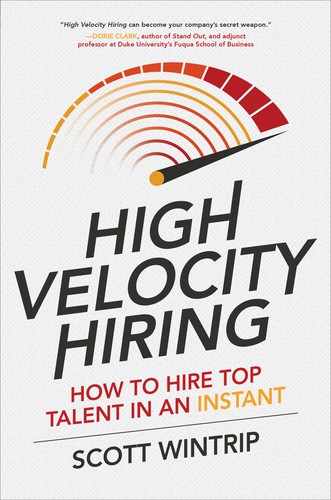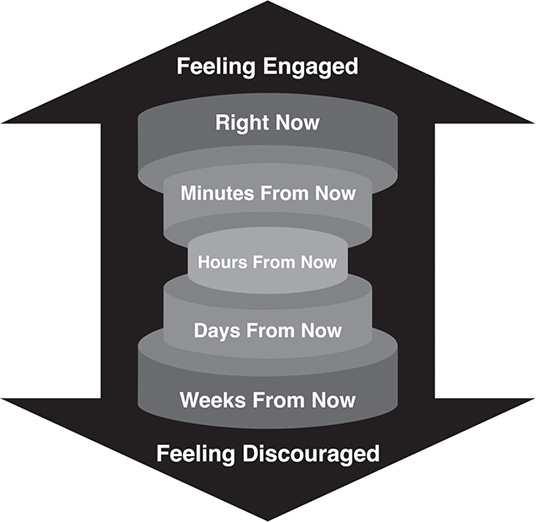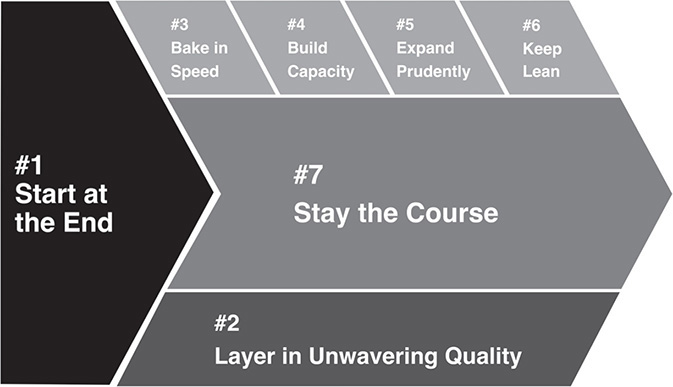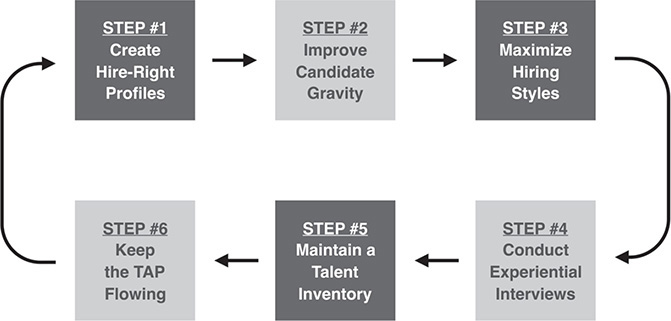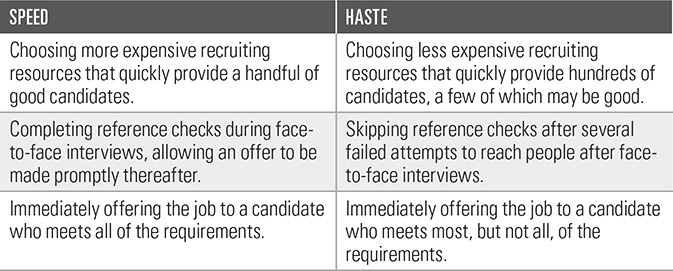The Talent Accelerator Process
Apply the Principles of the On-Demand Economy to Fill Jobs in an Instant
Once upon a time, if you wanted to watch a movie that had recently left the theaters, you had to take a trip to the video store first. After scanning the shelves and finding the right film, you’d pay a rental fee and head home, videocassette in hand. That entire process may have taken 20 minutes, and back then 20 minutes didn’t seem like much. But, in today’s on-demand world, when you can stream a movie in seconds, that same 20 minutes feels like an eternity. Breakneck speed is now the norm, and that speed keeps getting faster.
The need for speed has become a strategic requirement. Internet service providers continue one-upping each other by stomping on the download accelerator. Just a few years ago, my cable Internet service boasted a top speed of 40 megabytes. Today, I can web surf at seven times that speed.
Acquiring other services and products has also gotten quicker. Getting a massage while I’m traveling between speaking events used to require booking ahead. Now there’s an app for that, which promises to have a licensed massage therapist at my door in an hour. I love the smell of books at my local bookstore, but it can be inconvenient to drive five miles when I can download a book in five seconds. Consider food, software, handyman services, stock trades, event tickets: The list of what we can buy, rent, or use now or minutes from now grows by the day.
In our on-demand world, we have come to expect that we should get what we want when we want it. That’s the secret of fast, accurate hiring: Implementing a process that allows us to hire who we need, when we need them. It’s about filling an open seat right now. Not weeks from now.
Our insatiable appetite for products and services on command has led to the creation of the on-demand economy. It becomes safe and easy to hire with speed when we apply the principles of the on-demand economy to employee recruitment. That’s the essence of High Velocity Hiring—gaining the power to hire right now.
The Power of Right Now
Instant gratification drives the on-demand economy. The buying of products and services has been sped up by the Internet. However, the roots of on-demand can be found in a surprising place—automobile dealerships.
One of my summer jobs in the 1980s was working in a dealership, selling cars. I made a respectable commission. What was more valuable to me, though, was witnessing the power of immediacy. My job was to get people behind the wheel for a test drive. The firsthand experience of driving a car was more compelling than anything I could say. It was only natural after a test drive that a buyer would want to keep driving that car. Who can resist that new car smell?
To turn test drivers into same-day buyers, the dealer incorporated immediacy into the sales process. They’d let potentially creditworthy customers “buy” the car today. These customers would drive off the lot smiling, thinking the car was theirs. Actually, it wasn’t. Not yet.
For decades, the fine print in automobile purchase agreements has granted dealers the power to cancel a purchase. Even after you sign the paperwork and hand them a down payment. Why? Because it takes a few days to verify your creditworthiness and locate financing for the contract’s precise terms.
Do dealers end up cancelling deals? They do. At one particular dealership in Tampa Bay, Florida, it’s not unusual for a couple of deals to be cancelled each month. A sales manager there told me this practice is worth the risk, because it allows them to satisfy everyone immediately. The buyer keeps driving the car and the dealership pulls the customer off the market. As he put it, “When they think their needs have been met, people stop looking. They drive their new car home, instead of shopping at other dealers.”
That’s the power of right now. Immediacy is engaging; delays are discouraging (Figure 2.1). When we get our needs met right now, we needn’t keep looking. The longer that we have to wait, the more likely we are to consider other options.
FIGURE 2.1 The Engagement Spectrum
A long hiring process is discouraging, prompting people to take matters into their own hands. Top talent will seek other opportunities when an employer fails to act quickly. Hiring managers will circumvent company policies when their jobs remain unfilled. Staffing agencies will shop candidates to other customers when buyers take too long to respond.
A fast on-demand approach to filling jobs leverages the power of now. When we’re part of an efficient, forward-moving process, we feel in control. Feeling in control is satisfying and engaging, making it easier to trust the process and those who run the process.
Immediacy satisfies our human desire for instant gratification. Being able to buy almost anything from one source is convenient. Being able to buy it right now is gratifying. So much so that it’s changed our expectations about the buying experience.
The Everything Store
Amazon.com has become a model for one-stop shopping. If your family is like mine, the Amazon name shows up on your credit card statement each month. Our list of purchases varies—books, batteries, allergy medicine, a coffee grinder, a kayak rack—but our reason for buying from Amazon is always the same. We trust the process. This process allows us to buy and receive products with relative ease and speed.
Amazon understands that selling a variety of products isn’t enough to remain competitive. They recognize the importance of speed. In his book on the company, The Everything Store, Brad Stone shares details on how Amazon retains its competitive edge. This includes operating a group within the company called Competitive Intelligence. The group purchases large volumes of products from rivals and measures the quality and speed of their rivals’ services. If Competitive Intelligence finds that a competitor is doing better than Amazon, the company addresses this emerging threat.1
Rather than just reacting to threats, Amazon has found ways to proactively increase value and speed. In 2004, the company began exploring a speedy shipping club for customers who needed products quickly.2 The idea became Amazon Prime, a membership that includes free two-day shipping plus streaming videos, music, and eBooks. According to Stone, “The service turned customers into Amazon addicts who gorged on the almost instant gratification of having purchases reliably appear two days after they ordered them.”3
In the on-demand economy fast keeps getting faster, and Amazon remains at the forefront of this acceleration. Amazon Dash allows customers to buy more than 100 products at the press of an in-home button. Customers order a branded button for a particular product, such as Tide or Doritos, place it in a visible spot, and sync it to the Amazon app. Then, when they run low on that item, they push the button, and it’s on its way.4
Quick results are never an accident. Companies must mindfully consider the impact of acceleration on customers, suppliers, and their own organization. They plan a strategy that sustains or improves quality as speed of delivery increases. In executing the strategy, they carefully implement their plans, starting small and expanding with care. To maintain the benefits of their high-velocity delivery system, they work to keep their methods lean and efficient.
To get started, any organization wanting to achieve faster results—be it faster procurement of products, quicker access to services, or speeding up the filling of jobs—has to answer the following two questions:
• What can we do to increase speed without sacrificing quality and accuracy?
• How do we make this new speed sustainable?
Speed Versus Haste
When you answer the two previous questions about faster hiring, you aren’t just thinking outside the box. “Sometimes, you have to blow up the box,” said Obed Louissaint, vice president of people and culture for IBM Watson. That’s exactly what Louissaint did when he joined the group’s management team.
The goal of IBM Watson is to lead society into the next era of computing, creating new tools that help people do what they couldn’t do before. To achieve this, Louissaint and his recruiting team had to ensure they had qualified people, exactly when they were needed—without ever hiring in haste.
“There’s a big difference between speed and haste,” said Louissaint. “Haste has no place in employee selection. Rushed decisions often lead to poor choices. These mistakes result from an ineffective approach that wasn’t built to deliver fast and accurate hires. Speed is different. It is simply part of a well-planned process for achieving great results quickly.”
Rather than make hasty hiring decisions based on whim, Louissaint has formally baked speed into IBM Watson’s process for talent acquisition. “The operative words are plan and process,” he says. “Fast and accurate hiring isn’t a fluke. It happens because leaders plan for it, implement a process to achieve it, and hold people accountable to following the plan.”
Paradoxically, hiring quickly can’t be done in haste. Haste causes harm to companies and careers. Organizations need a streamlined employee selection process that allows them to make intelligent decisions without cutting corners or compromising values.
Seven principles underlie the on-demand economy. Applying these principles allows companies to deliver their products and services with speed, not haste. When applied to hiring, these same principles allow organizations to design a recruitment process that is fast, accurate, and efficient.
The Seven Principles of an On-Demand System
Applied in order, the following seven principles create the framework for increasing speed without sacrificing quality (Figure 2.2).
FIGURE 2.2 The Seven Principles of an On-Demand System
Principle #1: Start at the End
Jeff Bezos, founder and CEO of Amazon.com, didn’t just wake up one day and decide to start selling memberships for Prime. The idea was suggested by Amazon engineer Charlie Ward.5 He recognized that not all Amazon customers are price conscious; some have needs that are time-sensitive. His recommendation for a speedy shipping club resulted from his awareness that the company could better meet the needs of customers who wanted expedited shipping. To make this idea work, Amazon had to identify and overcome pitfalls and then sell the positive impacts of this new service.
Starting at the end allows organizations to determine why there is a need for faster results and the impacts, positive and negative, this will create. Specifying the desired outcome and its positive impacts makes it a tangible goal, one whose benefits can be easily communicated. Taking time up front to identify potential pitfalls allows leaders to design a process that addresses those issues.
Deciding to hire faster starts at the end. Your company will need to decide whether it wants to fill one, several, or many jobs in an instant. That decision will have positive impacts that help you engage your colleagues, and possible pitfalls that will require attention. That’s why this principle is the first and most important. It will guide every other decision you make.
Principle #2: Layer in Unwavering Quality
My experiences with taxis has been mixed. Dirty cabs, smelly drivers, and frightful driving turned some cab rides into an adventure. Not so with Uber. Clean cars and drivers who got me to my destinations with care have made me a repeat customer. A friend who works for Uber explained that drivers agree to maintain a high standard of professional service. When a customer complains, the company follows up to address the issue, terminating relationships when those issues persist.
Maintaining quality as speed increases has to be an immutable standard. How? It’s part of the plan. Methods are included in the process that ensure and measure quality, including steps for rectifying any problems that arise. Speed and quality become interdependent rather than mutually exclusive.
Speed can never supplant quality when hiring. The two must go hand-in-hand. An accelerated process has to improve quality, ensuring that your company can quickly make smart choices versus hires you later regret.
Principle #3: Bake in Speed
Companies who deliver on-demand prepare to be fast. Take Jimmy John’s for example. Late one night, I was the sole customer dining in at a Jimmy John’s outside of Milwaukee. I watched staff members carefully weighing meats and cheeses, stacking them between sheets of deli paper. Bins were filled with sandwich toppings, bread was set out at prep stations, and bags and cups were stacked in their appropriate spots. This is why Jimmy John’s can offer freaky fast delivery. At the end of each day, they prepare to be fast tomorrow.
A faster process has speed baked in. This includes a streamlined system for achieving the end result, including methods that address those previously identified pitfalls. Simplicity is also baked in to assure sustainability and ease of communicating the process.
Hiring is more complex than building a sandwich. However, it’s become an overly complicated, slow process with too many steps and too much effort. Streamlining how hiring is done requires that you do less labor-intensive work that achieves better hires quickly.
Principle #4: Build Capacity
The initial introduction of Amazon Dash was by invitation only. Controlling the number of customers who accessed this new service allowed the company to mindfully roll out, test, and tweak the program. A few months later, it was made available to the general public for a limited number of products, the next phase of mindful expansion. The rollout expanded from there to include Dash buttons for other products.
Building capacity starts with preparation, coordinating plans for implementation with competing demands and the availability of time and resources. The initial rollout is done with care, without unnecessarily overtaxing people or systems. Capacity is increased prudently, allowing for adjustments and changes to the process, as necessary, to maintain quality and speed.
Implementing a faster hiring system will require that you have the same degree of thoughtfulness. Your timelines and deadlines should be considered carefully. You’ll need to allocate adequate time and resources without undermining other initiatives. Like many organizations, you may choose to start with one position in one department, leveraging positive results as a catalyst to incrementally increase capacity.
Principle #5: Expand Prudently
Netflix has become an award-winning producer of original series like House of Cards and Orange Is the New Black, an impressive result for a movie rental company. The evolution from delivering DVDs by mail to a streaming movie service to an Internet television network exemplifies prudent expansion. The leaders of Netflix had to plan, execute, and troubleshoot their growth carefully while always keeping the end in mind: Providing members with the ability to watch as much programming as they want, anytime, anywhere.6
Maintaining fulfillment capabilities beyond market demand is a requirement for prudent expansion. Immediacy is always at the heart of being on-demand. The end-goal is always top of mind, guiding efforts and focusing ambitions. Plans are constantly compared to desired results; what contributes to the goal is maintained and what detracts from the goal is removed.
Fast and accurate hiring requires vigilance: Your process should be expanded prudently and never be pushed to deliver beyond its capabilities. Your colleagues must be able to trust the process.
Principle #6: Keep Lean
Surprise projects with short deadlines are common in today’s world of work. For instance, my colleague Sam recently needed a press release, a task he had never undertaken before. He turned to his favorite “get it done quick” resource—Upwork. This on-demand provider of freelancers boosts 12 million workers, matching them to projects like Sam’s. It took him just a few minutes to post his need by answering a handful of questions and checking a few boxes. Later that day, 12 freelancers had applied, one of whom Sam selected for the job.
Managing a platform of millions of people who do $1 billion in work for five million customers is no small task.7 Upwork has had to keep lean as it’s grown big, avoiding wasted time or effort. Their team has to serve customers, implement new ideas, and fix problems while maintaining a speedy and accurate matchmaking service.
Keeping an on-demand system lean is essential in meeting the shifting demands of customers. Technology must reduce effort. Time has to be spent wisely. Resources need to be conserved. Maintaining the system requires constant attention, with focus on finding and eliminating wasted time, resources, and effort. Fast delivery of products to people or people for jobs only happens when your lean and efficient system can make that happen.
Principle #7: Stay the Course
For an on-demand plan to work, that plan needs to be followed. Sometimes, doing so is easier said than done. After all, the economy ebbs and flows, markets change, and employees come and go. There’s a lot to attend to, and some of it is unpredictable.
All of the companies highlighted in these principles, however, have achieved success because they’ve stayed the course. They may adjust plans or improve their process, yet they know that consistent action is a requirement for delivering quality products and services with speed and accuracy.
Fast hiring isn’t a one-time event; it’s a commitment to a process. Your organization will need to plan, implement, and sustain a faster hiring process, and then stay the course. This will also require consistent execution and continuous improvement, keeping the endgame—being able to hire top talent in an instant—always top of mind.
The Principles in Action
Filling 300 jobs can be a challenge. Filling 300 jobs when you can guarantee only a few months’ work would make it much harder. Doing so in five weeks could seem impossible.
Eric Houwen was faced with this task in 2015. As the recruitment manager for CAK, Houwen’s team was responsible for recruiting talent for open jobs. CAK, a government-related organization, plays a central role in Holland’s complicated healthcare system. The organization collects and analyzes data from thousands of institutions and agencies, calculates the associated healthcare charges, and bills and collects payments from consumers.
In January 2015, a new set of regulations altered the amount consumers had to pay, and CAK knew their call center would be bombarded by queries from people questioning their bills. In preparation for these calls, CAK realized they’d need to hire 300 additional call center employees. These employees had to be in place by the time consumers received their next bill, just weeks away.
“Our recruiting team would typically work on 80 jobs a month,” said Houwen. “Because of this project, our workload increased nearly 500 percent overnight.” Houwen’s job was made even harder by a number of factors. “The majority of our recruiting team dealing with this project was new to CAK. Plus, we were recruiting in a new region as well. In trying to get people interested in the job, we could promise them only a few months of full-time employment. This project was thrilling and daunting.”
The short timeline didn’t lessen the demand for making quality hires. “There were no concessions to be made,” said Houwen. “This initiative was too important to settle for subpar talent. New hires would need excellent communication skills and had to be able to ramp up quickly. We had to find a way to take our existing vetting process and somehow squeeze it into the amount of time we were granted.”
With the end-goal and timeline set, Houwen and his team had to develop a faster approach. They implemented an on-demand process that allowed them to review hundreds of candidates a day. These candidates were initially sourced from numerous resources, including job boards and referrals. To keep the process fast and lean, they quickly narrowed these resources to those that were generating the best candidates. Interviews were also quick and efficient; recruiters were able to swiftly assess who fit their rigorous standards and who did not. The recruiting team rapidly gained momentum, allowing them to build and expand capacity quickly.
Did they succeed in hiring and onboarding 300 call center agents in five weeks? Yes, and feedback about the quality of these hires was excellent. “The first week our call center managed 36,000 calls,” said Houwen. “We couldn’t have done that without adding those extra agents.”
Houwen has moved on to a new role, but this experience left an indelible impression. “That kind of an assignment is why we became recruiters. It was a chance to make a real difference. And we did. We built an effective on-demand hiring system in a matter of weeks. The quality of those employees ended up being as good, or even a little better in some cases, than hires we had made before. I know that faster hiring isn’t just possible. We’ve proven it works.”8
Push-Button Hiring
When a job opens, wouldn’t it be nice if you had a button, like Amazon’s Dash, which once pushed would fill your job in an instant? There may not be a button, but there’s a process—one that incorporates all seven principles of an on-demand system. It’s called the Talent Accelerator Process (TAP) (Figure 2.3).
FIGURE 2.3 The Talent Accelerator Process (TAP)
TAP is the engine that propels High Velocity Hiring. By design, it allows your company to fill one job or many roles in an instant. Quality and speed are incorporated into every step, ensuring you can quickly and accurately select the best people. TAP lets you build capacity at your pace and expand its use as you see fit. While the process is inherently lean, methods are provided to help you keep it fast and efficient. Staying the course simply requires maintaining a healthy flow of quality candidates. TAP is the practical application of the new way of hiring: Actively cultivating top talent and then waiting for the right job to open.
The operative word in High Velocity Hiring is flow. The Talent Accelerator Process enriches the flow of candidates by drawing in more people with the correct qualifications. Harnessing this flow leverages human perception during interviews, providing proof that someone is, or is not, the correct fit. Creating a pool of ready-to-hire, prospective employees sustains the flow, enabling your company to hire on-demand. The next six chapters will walk you through each step of TAP, providing all of the details you need to engage in High Velocity Hiring.
Starting at the end is the most important of the principles of an on-demand system. That’s why our next chapter focuses on hiring profiles. You must know who is a good fit if you’re going to find and select the right people. Unfortunately, many leaders avoid creating or using hiring profiles, finding them time-consuming to create. Not so with Hire-Right Profiles. By the end of the next chapter, you’ll be ready to write your first one in 20 minutes or less.
